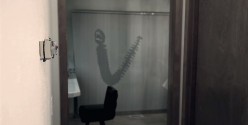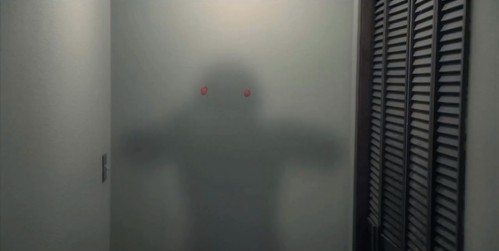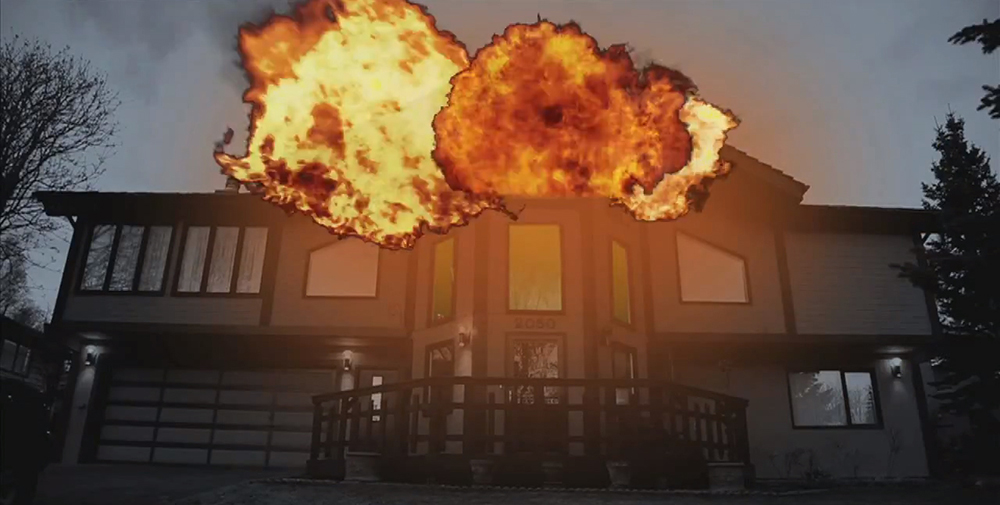Aberrations
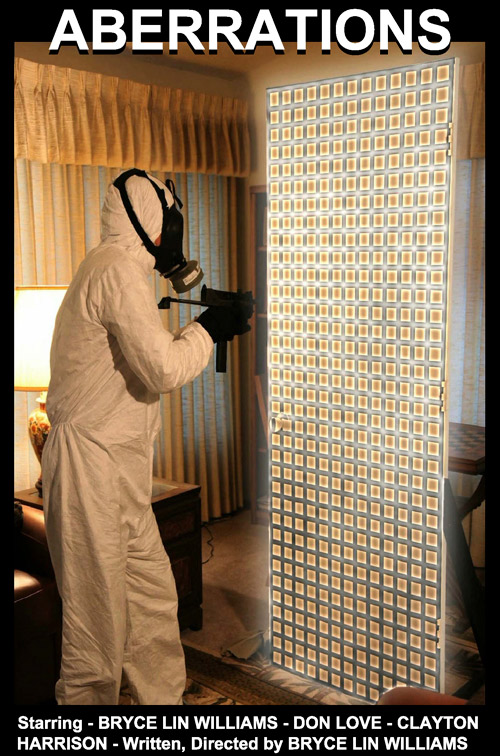 Director: Bryce Lin Williams
Director: Bryce Lin WilliamsExpected Rating: PG-13 for some violence and language
Distribution: No known distribution
Budget: $100
Genre: Sci-Fi/Action/Horror
Release Date: October 18, 2012
Official Website: N/A
Trailer: N/A
Running Time: 19 min. 52 sec.
Review Issue: Issue #91 (09/13)
Reviewed By: Mike Flanagan
Final Score: 5.0
A nearly bankrupt photographer is out taking pictures when he encounters a strange man in a dark hood. The man opens fire, and the Photographer (also an accomplished marksman) fires back. Wounding the man, he’s unable to confront him, but finds a box left behind that contains several unusual camera lenses.
At home, he tries out the new lenses and realizes that they seem to have the ability to photograph paranormal phenomena, primarily auras and strange, shadowy shapes of other worldly creatures. When the owner of the magazine that publishes his work sees them, he encourages the photographer to take more pictures, promising a handsome payday for photographic proof of the supernatural.
But as he experiments more with the camera, he finds out that the lenses don’t only photograph things from the “other side,” they can also open a gateway between our world and the next. Armed and desperate, he decides to step through one of the gateways and return with something that will mean the end to his financial woes… but also, possibly, his life.
Content
Bryce Lin Williams shot Aberrations for a mere $100. Often, he would serve as his own D.P, turning on his camera and running in front of the lens to read his lines (he also plays the lead role). He had no sound department, and so would have to dub most of his lines in post. This is pure DIY filmmaking, and Williams deserves credit and admiration for literally being a one-man film crew to create this Lovecraft-flavored tale of other worlds, bizarre creatures, and a desperate man out of his depth.
This is a film with some pretty big ideas. That it was pulled together for only $100, significantly less money than is usually in the petty cash envelope on micro-budget shoots, is inspiring and commendable. That he is also taking a shot at a significant number of VFX shots, dealing with alternate universes and hinting at a considerably larger world than his resources would allow, is again commendable.
However, there are pitfalls that are simply unavoidable when operating as a one-man band. Films are a collaborative art form, perhaps the most collaborative in the world. They depend on the cohesion of numerous talented individuals to come to fruition. Because of his limited resources, both financial and in regards to personnel, Williams is forced to bear the brunt of the entire film on his own shoulders. This creates weaknesses that are unavoidable, and of which the filmmaker is undoubtedly aware. But it doesn’t change the fact that, while an undeniable achievement by a clearly passionate filmmaker, Aberrations is never really poised to achieve its potential.
It is Williams’ many hats that cause the film the most problems out the gate. His acting isn’t going to carry the story, because (I suspect) he is not a trained actor. He has very few lines, but the ones he has are delivered with an odd sense of strain… this is also, perhaps, due to the fact that they are predominantly overdubbed.
He appears to be a filmmaker forced to play the lead in his own creation out of necessity, and as a result the viewer is never invested in the lead. Williams’ onscreen presence is more a means for Williams the Director to move from one narrative beat to the next. I assume this is due to lack of access to a serious talent pool, but it is a hurdle that the film’s technical achievements and DIY charms never quite overcome. In the future, I imagine that Williams will be well served by the freedom afforded him as a director by not having to juggle his own performance with the technical aspects of directing a film.
I’m reluctant to critique plot elements, as again, I assume that this is a predominantly academic exercise that the filmmaker is using as a platform for learning, but exactly because of that I must point out a few plot questions that also distract from the experience.
First, we are never really told why a strange man opens fire on the Photographer early in the film. It is a random act of violence necessary only because our hero must find the lenses somehow. But without a clear motivation, it comes off as a convenient plot device. He shoots the mysterious man in the hand, and later we see the Magazine Owner cutting him a check while sporting a bandage on his hand. The implication is that he was the man with the gun, but I’m not certain… and if he was, why go through this at all? Why encourage him to use the camera?
If it’s money that is driving the Photographer’s actions, surely the shadowy forces trying to recover the lenses, who are aware that he has them, should have thought to simply purchase them back.
These are minor grievances, admittedly. The film doesn’t belabor these points, as I’ve done, but rather moves quickly into the second phase of the story, wherein the lenses open gateways into “the other side.” This is another element that was unclear for me… it’s a fairly easy leap to accept that the lenses can capture images that we cannot perceive, but I’m not sure how simply having the lenses in a room will open a physical gateway that a person can step through. Except, of course, that this is necessary to achieve the point of the narrative, which is the Photographer’s journey to the Other Side.
Here, Williams displays what I believe is the purpose of this film for him. Moments of action, punctuated with appearances of strange, inhuman creatures. Considering his budget, the effects on display here are worthy of praise. However, lacking any budgetary information, they wear their digital origins on their sleeve. In a vacuum, these are not particularly convincing effects. But with his budget, he’s clearly out on a limb and stretching his resources as far as he can.
Ultimately, the film doesn’t have the weight behind it to punch in the same class as its ideas. Williams is ambitious, and that ambition comes across loud and clear in his final act as he stages explosions, gunfights, and an onslaught of strange creatures.
The pacing of these sequences is hindered by a constantly static camera, an unavoidable consequence of Williams operating his own camera while being on screen. The result is that there is little sense of escalating tension or rising action, whereas a moving camera and a more frantic editing pace would have surely landed these sequences on a higher note. Still, it climaxes in a fun way and one can only imagine what would have transpired if Williams had a crew backing his plays.
Ultimately, this film presents itself as the work of a filmmaker still in the learning process, and having to take on a huge amount of the responsibility himself. There are big and bold ideas at play here, and I think that if Williams is able to expand his resources when it comes to money, crew and cast, he’ll be able to create a canvass on which he can truly express his big, ambitious ideas. As a testament to DIY filmmaking, this is an impressive effort and must have been an extraordinary labor of love. As a standalone film without the context of its practical limitations, it falls short of being the piece of entertainment it could be.
Visual Look
Williams knows his way around a camera and uses his Canon 5D Mark 2 well. Composition, lighting and focus are consistently good. He employs an interesting desaturation in order to differentiate the Other Side from our reality, and has conceptualized some dark creatures (most notably a flying snake monster) that are imaginative and memorable.
There are some VFX shots that don’t quite have the polish of the rest of the film–specifically a few explosions and some rough-around-the-edges fire effects–and they can be a little distracting.
The biggest thing I think he can improve upon is moving the camera. Granted, he didn’t have that option in this case, but there are sequences of the film that are just begging for some kinetic energy. The static framing actively works against a sense of rising action and is lethal to the pace of the piece. Clearly proficient with his camera, Williams simply needs the time and resources to branch out into more dynamic camera work on future projects. [Editor’s Note: If actually moving the camera isn’t possible due to continued lack of help or due to the need for adding effects, then the filmmaker may wish to check out VideoCopilot.net, an online training service that freely helps people use After Effects. One of the tutorials shows how to create an artificial hand-held camera shot with the Wiggler dynamic in After Effects. Shots that are turned into motion shots in post are much easier to add special effects to, since the effects plate is added to a non-moving shot, and then all of the plates are animated to resemble a motion shot afterwards. –JH]
Use of Audio
As with most films of this size, the sound is thin. A lot of the dialogue is ADR, and while standout moments with specific sound design are given heft (gunshots, explosions, and the sounds that the creatures create), a lot of the rest of the film sounds light in its sound work. More world tone would help fill out his exteriors and make the whole thing seem bigger, and a bit more attention to interior sound design would make the world feel more lived in and authentic and less sterile and cursory. [Editor’s Note: For future work, consider our overview on audio for microfilmmakers. –JH]
The score is serviceable but unobtrusive, and ultimately did not make a huge impression. During some of the more fantastic elements, the score’s synthetic nature betrayed the budget, but it was always appropriate to the images and it is better that a score be unobtrusive than distracting.
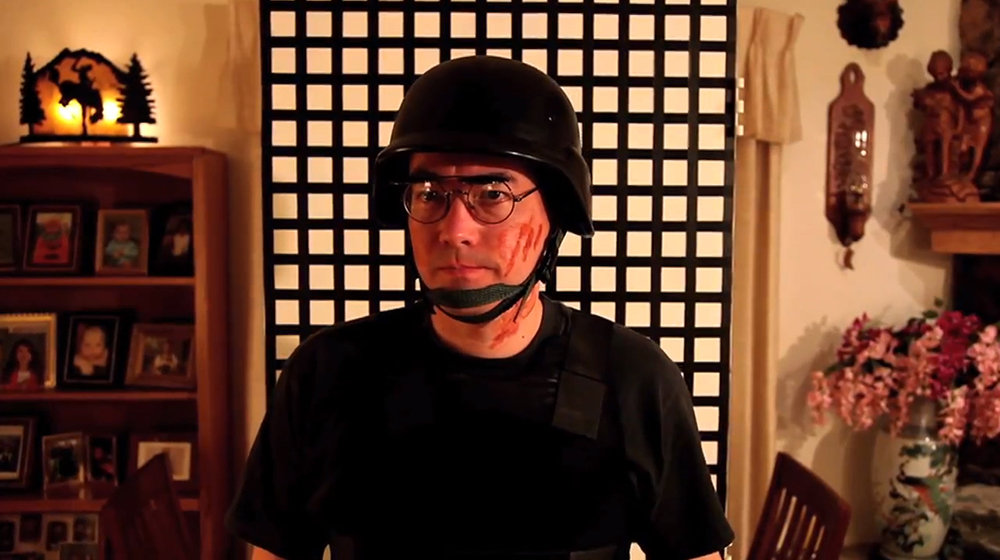
Bryce Lin Williams accomplished this film essentially as a one-man band: writing, directing, and starring.
Use of Budget
This is where Williams shines. $100… that’s just absurd. To create a 20 minute piece that is heavy with VFX and as ambitious as his narrative is, is quite an accomplishment. In fact, the budget is so small that I’m reluctant to fault the film’s technical and narrative problems. While not all of his VFX are as polished and convincing as they could be, this is a filmmaker out on a limb with almost no resources. For what he had to work with, Williams should be very, very proud.
Lasting Appeal
The most appealing thing about this movie is the story of its creation. The one-man-band, DIY nature of Aberrations is its biggest strength. As a learning tool for a budding young filmmaker, this movie is utterly successful. I hope it encourages him to push himself further in future installments and to bring others into his craft so that he can truly embrace the collaborative nature of filmmaking.
Outside of the narrative of its creation, Aberrations will only appeal to fans of no-budget filmmaking and possibly those who enjoy Lovecraftian horror and sci-fi. This is a film that functions best as a learning piece, and its audience outside of that narrative will be limited.
Overall Comment
A fine example of DIY filmmaking, Aberrations shows what one ambitious person can accomplish with no resources. A great training film, and hopefully a platform from which Williams can expand his craft.
|
Breakdown
|
|
|
Content
|
4.0 |
|
Visual Look
|
5.0 |
|
Use of Audio
|
3.0 |
|
Use of Budget
|
9.0 |
|
Lasting Appeal
|
4.0 |
|
Overall Score |
5.0 |
| How do we critique films? Click Here To See. | |








